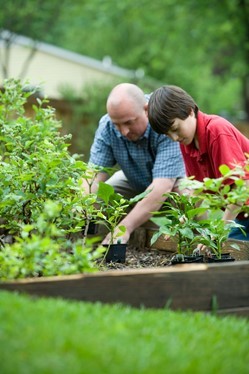WATER QUALITY IMPROVEMENTS

Garden Design Tips with Pollution-Prevention in Mind
Summer is right around the corner. Now is a great time to not only satisfy your thirst for summertime gardening activities, but to also be mindful of water-thirsty gardens. Gardens need a lot of watering and there are actions you can take to help your gardens conserve and absorb the water they are receiving to prevent excess water from leaving your yard. Excess water (runoff) can pick up harmful pollutants as it flows into our storm drain system, eventually reaching our waterways. Unlike our sanitary sewer system, water that flows through our storm drain system is NOT TREATED and can have a negative impact on our local waterways and ocean.
|
Follow these tips to prevent wasting water, prevent water pollution, and preserve the future of our natural resources.
-
Plant California Friendly and native plants that are adapted to long, dry summers and short rainy winters and therefore don’t need much water. Consider replacing your lawn with low-water-consuming plants or ground cover. Participate in the Turf Replacement Rebate Program or learn about water-wise garden design and landscaping through the WaterSmart Landscape Makeover Program. Visit the California Native Plant Society for information on California Friendly plants and other helpful resources.
-
Group plants with similar watering needs in the same area based on plant type and differing water requirements. Shrubs tend to need one-third to two-thirds as much water as lawns do, and with more robust root systems, benefit from less frequent but deep watering. Standard spray heads, rotating sprinklers and drip irrigation all apply water at different rates and should be adjusted accordingly based on plant type and watering needs. It’s also important to be mindful that new plants will have different water requirements than established plants.
-
Mulch and add compost to soil to minimize evaporation and help soil absorb and store water. Mulches can be either organic or inorganic. In addition to improving soil absorption, organic mulches also add nutrients to the soil, which is very important for water-efficient landscaping. Learn the basics of mulching here and visit these local facilities to purchase mulch.
-
Install permeable hardscapes (such as gravel and pavers) and stormwater retention features (such as berms and basins) to improve water absorption, slow the flow of stormwater, and capture runoff.
Gardening maintenance activities such as fertilizing, and pest control also contribute to water pollution. Visit the County’s Educational Handout webpage for tips on how to prevent fertilizers and pesticides from impacting our waterways. Also, be sure to properly dispose of any unused products at your local Household Hazardous Waste disposal facility.
For more information on water-wise gardening/landscaping techniques, see the San Diego County Sustainable Landscape Guidelines and San Diego Water Authority WaterSmart web page.
 |
|
Click on the Sustainable Landscape Guide photo to the left to open. |

|
|

|
|
Find My District
|

|
ONLINE SERVICES
Report Stormwater Pollution
Report observed pollution to the correct jurisdiction.
Citizen Access Portal
Research property information and permits. Apply for some permits online.
GIS Maps
Find property information including zoning designation with our web-based mapping tool.
Watershed Protection Website
sandiegocounty.gov/stormwater

Project Clean Water efforts are focused on providing a centralized point of access to water quality information and resources for San Diego County Watersheds. Click HERE to visit Project Clean Water’s website.
|

|
|